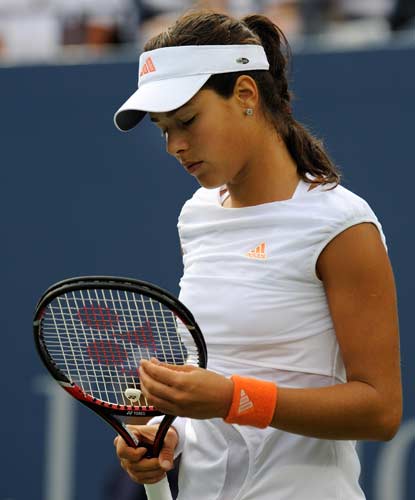Keothavong makes her presence felt as race to be No 1 gathers pace

Your support helps us to tell the story
From reproductive rights to climate change to Big Tech, The Independent is on the ground when the story is developing. Whether it's investigating the financials of Elon Musk's pro-Trump PAC or producing our latest documentary, 'The A Word', which shines a light on the American women fighting for reproductive rights, we know how important it is to parse out the facts from the messaging.
At such a critical moment in US history, we need reporters on the ground. Your donation allows us to keep sending journalists to speak to both sides of the story.
The Independent is trusted by Americans across the entire political spectrum. And unlike many other quality news outlets, we choose not to lock Americans out of our reporting and analysis with paywalls. We believe quality journalism should be available to everyone, paid for by those who can afford it.
Your support makes all the difference.It took Roger Federer more than four years to lose his position as the world No 1. It will probably take just three weeks for Ana Ivanovic's current reign at the top of the women's world rankings to end. At the start of play here yesterday Jelena Jankovic, Serena Williams, Dinara Safina and Elena Dementieva all had hopes of finishing at the top of the tree come the end of the US Open in a week's time.
Anne Keothavong, Britain's No 1, may have lost to Dementieva on Friday night and been shown the chasm that exists between her and the topmost branches of that tree, but she could not have picked a better time to give her profile a boost.
Defenders of women's tennis see the log jam at the top as evidence of its strength in depth. Critics see it as a vacuum, and insist that the sport needs strong champions. They point to men's tennis, which has thrived on the rivalry between Federer and Rafael Nadal, who took more than three years to make the final step up the ladder from No 2 in the rankings.
During Federer's unbroken reign there were no fewer than 14 changes at the head of the rankings on the Sony Ericsson Women's Tour and six worldNo 1s: Justine Henin, Amélie Mauresmo, Lindsay Davenport, Maria Sharapova, Kim Clijsters and Jankovic.
For a while it seemed that Henin and Sharapova would fight toe to toe for the top spot, but all that changed earlier this year. Henin retired abruptly, while Sharapova's long-term future has been thrown into doubt because of the shoulder injury that has kept her away from Flushing Meadows.
When Ivanovic won her first Grand Slam final at the French Open in June she seemed to have the world at her feet, but the past three months have been woeful for the 20-year-old Serb. She has played just three tournaments, losing in the third round at Wimbledon and Montreal and in the second round here. Having become the No 1 at the start of the summer, she was briefly overtaken earlier this month by Jankovic and will in all probability lose the position again here.
A thumb injury has not helped Ivanovic's cause, but somebelieve she has found life at the top hard to handle. "It takes a lot of time just to feel like a No 1," Dementieva said. "I think she has a very good, solid game, but there's extra pressure with this No 1 position. She's a very good, very athletic player. Maybe she was a little bit too tight on the court here, but it's something you have to learn to deal with.
"Everyone wants to reachthe top of the game, so it's quite open for a lot of players at themoment. I think it's very interesting for the sport, because we're going to see a lot of competition and a lot of tough matches because of this. It's extra motivation for all of us."
Svetlana Kuznetsova, ranked No 4, points out that most of the players at the top are comparatively young. "We're all new and I think we definitely feel a lot of nerves," she said. "Generations change so quickly. Most of us are 23 or younger.
"Since Justine left it's as though there's nobody left at the top. Everyone wants to get there, but we're also nervous about it."
Some players believe the ranking system is not weighted sufficiently in favour of the Grand Slam tournaments. Jankovic,for example, was able to reach No 1 despite never having played in a major final.
"To be No 1 you have to play a lot," Mauresmo said. "You definitely have to have quite a busy schedule, unless you win every tournament that you enter.
"There's no one that you feel is really comfortable out there, playing a strong game and being really consistent. There are certainly opportunities for other players to get to the highest level and create some big upsets."
The other leading women players all point to the continuing threat posed by the Williams sisters, but on current form the next No 1 may well come from Russia. Safina has had an outstanding year and has never looked back since losing to Ivanovic in the French Open final. Her only defeat, in three tournaments on hard courts this summer, was to Dementieva in the Olympic final.
Dementieva is also flying, which made Keothavong's spirited display on Friday night against the world No 6 all the more commendable. The British No 1, playing in her firstGrand Slam tournament outside Wimbledon, lost 6-3 6-4, but impressed with her confidence and aggression. Keothavong led 4-3 with a break in the second set and had two points for a 5-4 lead, but was never quite able to match Dementieva's consistencyat the crucial moments.
Join our commenting forum
Join thought-provoking conversations, follow other Independent readers and see their replies
Comments